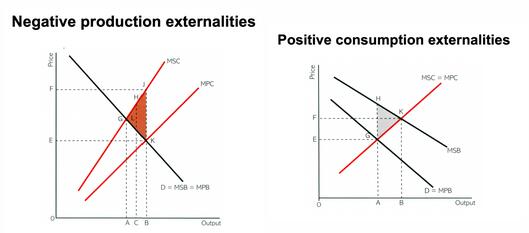
A-Level经济是热门A-Level考试科目之一,在A-Level经济的AS阶段,有一个重要的知识点——Externalities(外部性),这个知识点是14分和20分考题的高频考点之一,一定要拿下!为了帮助大家更好地理解和学会这一知识点,锦秋叶帆从真题考点等方面为大家详细讲解一下。
Definition
Externalities: effects on third parties (other people or firms) due to the consumption or production of goods or services.
外部性是在生产和消费产品和服务的过程中对第三方的影响。
外部性在人们生活中稀松平常,汽车驾驶过程中产生的噪音和尾气,工厂向河流排放的污水,人们餐馆里抽烟...这都是对未参与这些行为的第三方(the third parties)产生负面的影响,即negative externalities / external costs。当然也有很多经济活动对第三方产生正面的影响,即positive externalities / external benefits。一个很典型的例子就是疫苗接种(vaccination)。新冠疫苗接种的人越来越多,而对其他还未接种的人群来说,他们就从中获得了external benefits—即减少了感染的风险,并且不用为此进行支付或付出任何代价。
以上给出了生活中负的外部性和正的外部性的例子,在U1知识点中我们学习四种类型的外部性。即:
positive production externalities
negative production externalities
positive consumption externalities
negative production externalities

其中考生需要重点掌握的是negative production externalities和positive consumption externalities及其图像。图像细节这里就不具体展开,注意在论述题中需要结合图像进行解释。在negative production externalities中,MSC>MPC。在positive consumption externalities中,MSB>MPB。描述清楚market equilibrium price/ quantity,social optimum,welfare loss/ welfare gain。
在解答关于外部性的考题时,通常考生能较好挖掘出材料里的信息,也就是说application部分写得不错。但忽略结合application去进行深入分析(further development),只停留在问题表面,丢失了analysis的分数。
下面举例说明:

在这道题答题中,定义,图像以及材料的应用问题不大,但分析内容容易遗漏。

以extract一小段内容为例,在分析外部分时,答案往往写成“generating electricity by using coal was the largest source of carbon dioxide emissions in the USA. It emitted a total of 1.7 billion tonnes of CO2,leading to global warming, leading to global warming, melting polar ice caps and more severe weather. ” 几乎只摘抄材料里的信息,这样写可以得到application的分数,但analysis分数拿不到。这里同学们需要结合已有的信息和基础知识点进行拓展,比如我们需要指出承担外部性的third parties具体的external costs是什么。所以在前面的答案后面再加上“Third parties will be affected by flooding, which may damage properties. Those affected may have the costs of rebuilding or repairing homes…”。
这里的材料里的逻辑链:coal -> generating electricity -> carbon dioxide emission -> global warming -> flooding -> damage to property,在此基础上需要继续拓展:damage to property -> third parties ( property owners)-> costs of rebuilding or repairing homes without compensation。这样一个论点就能比较充分的展开,提升整体level。
总结
重点掌握Negative production externalities和Positive consumption externalities的定义、图像和描述,理解Third parties是谁以及对他们的具体影响。
更多有关A-Level科目及考试等方面的信息,大家可以扫码关注锦秋A-Level进行了解,锦秋A-Level紧抓中国学生理科优势,进行课程组合优化。开设数学、物理、化学、生物、经济学、会计学等课程,帮助学生以优异成绩申请更好的大学。

| 大学名称 | QS排名 |
|---|---|
| 麻省理工学院 | 1 |
| 剑桥大学 | 3 |
| 斯坦福大学 | 3 |
| 牛津大学 | 2 |
| 哈佛大学 | 5 |
| 加州理工学院 | 6 |
| 帝国理工学院 | 7 |
| 伦敦大学学院 | 8 |
| 苏黎世联邦理工大学 | 8 |
| 芝加哥大学 | 10 |
| 新加坡国立大学 | 11 |
| 宾夕法尼亚大学 | 13 |
| 洛桑联邦理工学院 | 14 |
网络优惠
预约试听
A-Level
雅思
留学咨询
留学规划